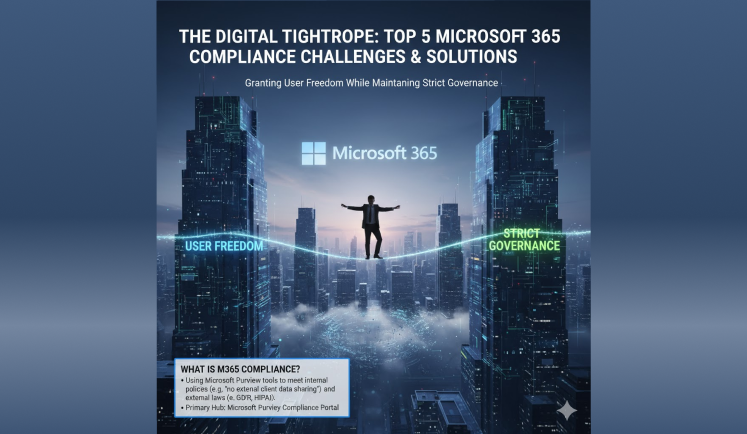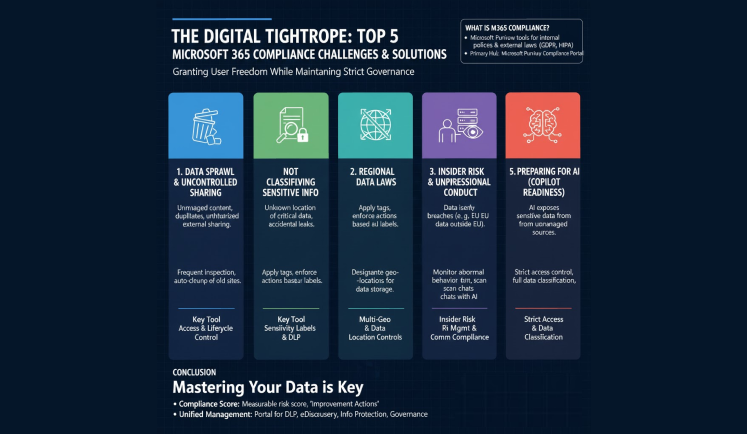The Digital Tightrope: Top Compliance Challenges in Microsoft 365 and How to Solve Them

In the current business environment, Microsoft 365 remains the leading productivity tool, where everything from private contracts to informal team discussions is stored. Nevertheless, these very features that facilitate easy collaboration and communication. Like easy sharing and constant communication, are the ones that can pose serious difficulties for Microsoft 365 compliance. Every company is forced to walk a very fine line in the digital world.Therefore, where it must grant users the freedom they need while maintaining strict governance at the same time.
Knowing the main problems is the first step to getting a proper compliance management system on Microsoft 365. The positive side of this is that Microsoft has made available a powerful collection of tools. Which can be used to reinforce the security and compliance of the Microsoft 365 ecosystem, to counter these very problems.
2. What is Microsoft 365 Compliance?
Before discussing the challenges, let’s first clarify what we mean by Microsoft 365 compliance. It refers to the use of Microsoft’s built-in tools (mostly within the Microsoft Purview suite) for the organization to manage and demonstrate its compliance. With both internal policies (for instance, “no sharing client data externally”) and external laws (such as GDPR, HIPAA, or local data retention rules).
The primary portal for this task is the Microsoft 365 Compliance Portal (which is now part of the Microsoft Purview portal). Through which one can have a single point of contact where sensitive data management, audit execution, and compliance score checking are done.

3. The Biggest Compliance Challenges and Their Solutions
Moving to the cloud has its advantages, but it also brings with it five major compliance challenges that IT and Compliance teams will have to solve one way or the other.
Challenge 1: The Chaos of Data Sprawl and Uncontrolled Sharing
The setting up of new Teams, SharePoint sites, as well as shared folders is so easy that there are a lot of content is created, and thus the content becomes increasingly unmanageable very quickly. In the absence of proper regulations, users start saving the same files in different locations. Giving and sharing them with unauthorized guests, and thus creating a disorganized and unmanageable area. The term “data sprawl” refers to this situation, which leads to a total lack of knowledge about the location of the sensitive data.
The Problem: Secret documents are mistakenly shared with outsiders, thereby breaching the privacy regulations, e.g., GDPR. The company simply overlooks the old sensitive data, thereby increasing the risk of making the data vulnerable.
The Solution: What you require is powerful Access and Lifecycle Control. This entails that you frequently inspect the team and SharePoint sites that house sensitive data, especially external guests, and automatically remove the users who have been inactive. Additionally, establish clear Lifecycle Policies by setting up automatic expiration and archival rules for inactive Teams and sites. This way, you will make sure old workspaces are either cleaned up or secured.
Challenge 2: Not Classifying Sensitive Information
You cannot safeguard what you cannot locate. Long ago, organizations used to be clueless about where their super-sensitive data is. It might be patient records, credit card numbers, or trade secrets even. Not marking this data is equivalent to keeping a bank vault open.
The Problem: An internal document mentioning the figures of not yet released profits is inadvertently sent to the rival company. Users do not comply with the rules and leak classified data.
The Solution: The solution lies in Sensitivity Labels and Data Loss Prevention (DLP). Microsoft Purview Sensitivity Labels can be used to create tags like “Confidential” or “Highly Restricted”. The application of these labels can be done either manually or automatically by AI. In the second step, DLP Policies can be created to implement the labels. For example, a DLP policy can be configured to prevent an email from being sent out of the organization. If it contains a document labeled “Highly Restricted,” thus avoiding data leakage.
Challenge 3: The Evolving Landscape of Regional Data Laws
Data must often stay in a particular country or region in order to meet local regulations (which is known as data residency). Microsoft 365, being a global platform, poses this challenge of complicated logistics for companies that have a presence in multiple countries.
The Problem: Data is in a region that breaches local data protection laws (for example, EU data stored outside of the EU). Audits require evidence of where the data is located.
The Solution: Using Multi-Geo and Data Location Controls. You have the option of configuring Microsoft’s Multi-Geo capability to identify which geographic location various user data and SharePoint sites need to be stored in order to abide by regional compliance. You can then utilize the Microsoft 365 Compliance Portal to create audit reports and demonstrate that your data is stored in line with rules.
Challenge 4: The Threat of Insider Risk and Unprofessional Conduct
Compliance is not only about outsiders; it’s usually about what happens within the company. Workers may unknowingly spill information, steal intellectual property, or exhibit harassing activities on chat channels. These “insider threats” are hard to track without invading people’s privacy.
The Problem: A worker is downloading a lot of sensitive documents prior to exiting the company for a rival. Harassment or illegal activity takes place in a Teams chat.
The Solution: Implement Microsoft Purview Insider Risk Management to track user behavior for abnormal patterns (such as unexpected download activity spikes) and alert them for investigation prior to the data exiting the organization. In the case of chat abuse, use Communication Compliance. This software employs AI to scan chats in Teams, Exchange, and Yammer for policy infractions (such as threats, profanity) and notify a specific compliance officer for examination, without compromising the privacy of regular users.
Challenge 5: Preparing for the Age of AI (Copilot Readiness)
The introduction of AI assistants such as Copilot in Microsoft 365 brings a new compliance risk. Copilot responds to user queries based on the enormous amount of company data it has access to. If your data is disorganized, not labeled, or over-shared, Copilot could inadvertently bring highly sensitive material to the attention of the wrong individual.
The Problem: An employee requests Copilot to give a summary of “all active projects,” and the AI shares a super sensitive project only intended for the executive team. Copilot is delivering incorrect results as it’s working from outdated, uncontrolled data.
The Solution: Strict Access Control is the most critical action. Because Copilot takes over the user’s permissions, if a user is not able to open a file. Copilot cannot read it out to them. Also, perform full Data Classification by marking all sensitive data with Sensitivity Labels and ensuring that old. Unnecessary data has been removed or archived with retention policies. It enhances compliance and the precision of the AI.

4. Streamlining Compliance using the Microsoft 365 Compliance Portal
Overcoming these challenges needs a concerted and persistent effort, materially supported by the features of the Microsoft 365 Compliance Portal (Microsoft Purview).
•The Compliance Score: This is the most useful compliance management feature in Microsoft 365. It provides you with a measurable, risk-based score depending on the controls that you have put in place. It offers an easy checklist of “Improvement Actions” to help you focus your effort, and it displays how you can achieve the maximum compliance points for minimal effort.
•Unified Management: The portal consolidates Data Loss Prevention (DLP), eDiscovery (for legal holds), Information Protection (Sensitivity Labels), and Governance (Retention Policies) tools. The unified methodology requires that you train your employees for a single control center.
Conclusion
Compliance with Microsoft 365 in today’s digital workplace isn’t optional. It builds business trust and ensures lawful operations. The main challenges range from data sprawl to AI-related security and ethics risks. All of them connect to one goal — understanding and mastering your data.
By applying data classification, enforcing access controls, and using Microsoft 365 tools like Compliance Score and DLP policies, organizations can turn these challenges into daily routines. Compliance management in Microsoft 365 is an ongoing process. With Microsoft Purview as your guide, you can protect sensitive data, meet regulations, and make the most of a secure cloud platform.


